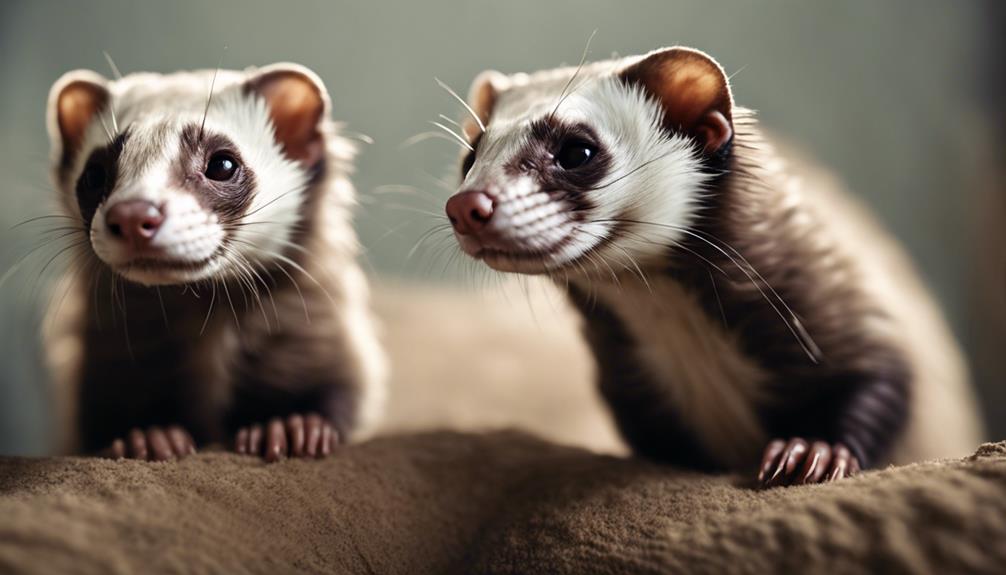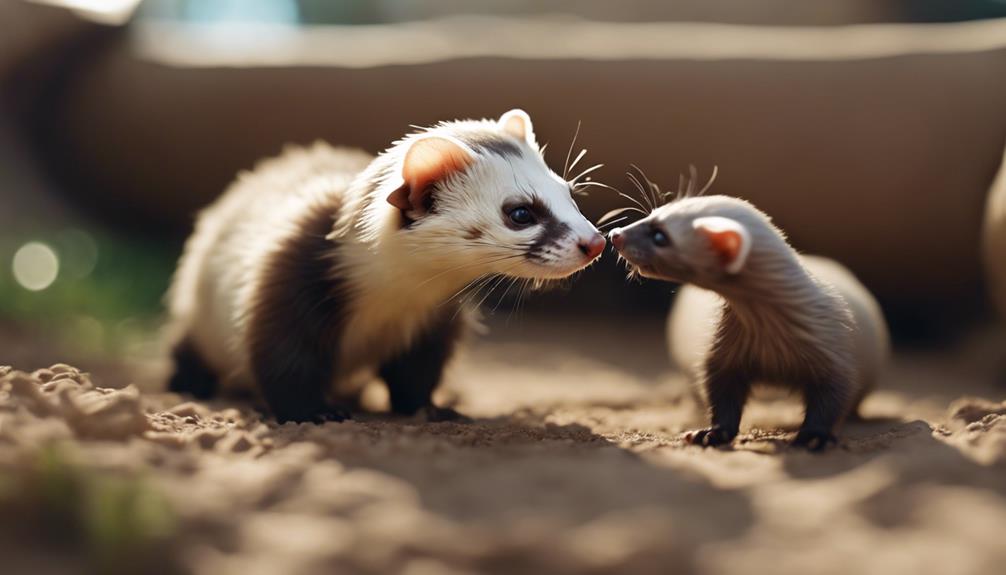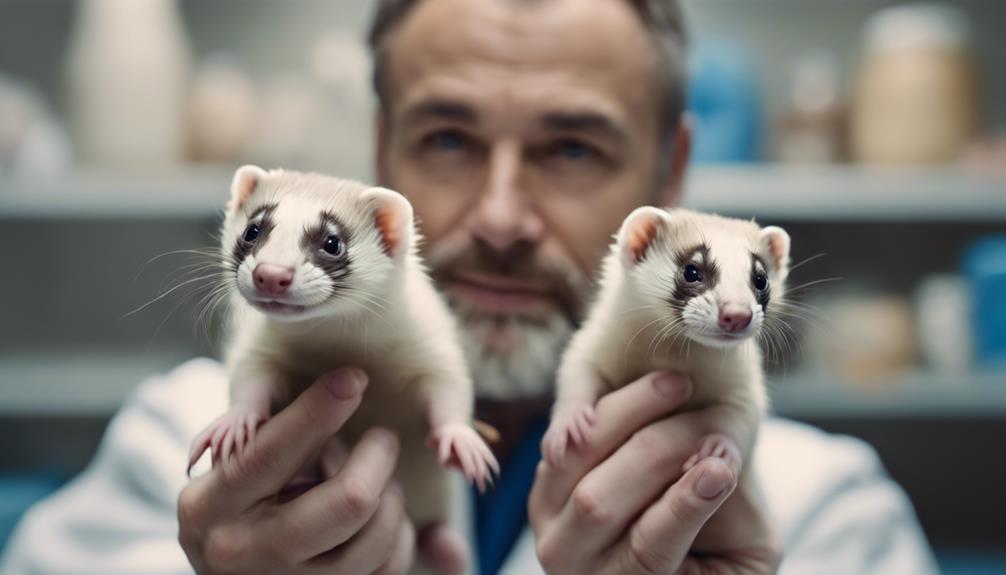How to Spot the Differences Between Male and Female Ferrets

Ferrets are playful and curious creatures that make fantastic pets. When trying to determine the gender of a ferret, there are a few key differences to look out for. Male ferrets, also known as hobs, tend to be larger in size compared to females, known as jills. One of the most noticeable differences is the scent glands found on the male ferret’s belly, which appear as bald spots.
In contrast, female ferrets do not have these glands. Additionally, male ferrets have a tendency to have a muskier smell compared to females. Another way to distinguish between the two genders is by observing their behavior. Males are often more territorial and aggressive, while females tend to be more sociable and playful. By being aware of these differences, you can easily identify the gender of a ferret and provide them with the appropriate care they need.
Understanding the distinctions between male and female ferrets is essential for their overall well-being. By knowing how to spot these differences, you can ensure that your ferret receives the proper care and attention they require. Remember to observe their physical characteristics, behavior, and scent glands to accurately determine their gender. Proper identification will enable you to provide a suitable environment and companionship for your furry friend.
Physical Size
Do you know how to tell the difference between male and female ferrets just by looking at them? Let’s explore some cool facts about their physical features!
- Size Matters: Male ferrets are usually bigger than females. On average, male ferrets weigh between 1.5 to 2.5 pounds, while females are a bit lighter, weighing around 1 to 2 pounds.
- Coat Color Clues: You can also spot a difference in their coat color. Keep an eye out for this unique trait.
- Body Build: Male ferrets often have a sturdier build and slightly longer bodies compared to females. It’s like they’ve their own distinct style!
- Length Check: Male ferrets range from 18 to 24 inches long, while females measure between 15 to 20 inches. That’s quite a size difference!
- Tail Tales: Look at their tails! Male ferrets have a thicker tail, up to 5 inches long, while female ferrets sport a thinner tail, around 4 inches. It’s like their tails have a story to tell!
Body Shape

Unlocking the Mystery of Ferret Genders
Have you ever wondered how to tell the difference between male and female ferrets? Let’s explore some key features that can help you identify their gender!
Body Shape:
- Male ferrets have a larger and sturdier body compared to females.
- Females tend to be more petite and slender in build.
Coat Coloration:
- Ferrets come in various colors like albino, sable, or silver.
- Male ferrets usually have thicker and coarser fur, while females may have softer and silkier fur.
Tail Talk:
- Male ferrets sport longer and thicker tails than females.
- The base of a male ferret’s tail is often thicker and more muscular compared to a female’s.
Head Shape

Discovering Gender Differences through Ferret Head Shapes
Have you ever wondered how to tell male and female ferrets apart? Well, one clue lies in their head shapes! Let’s explore some key differences to help you identify these furry friends:
- Muzzle Length: Can you spot a slight difference in the length of their noses? Male ferrets tend to have slightly longer muzzles compared to females. Keep an eye out for this subtle distinction!
- Cranial Structure: Take a closer look at the overall shape of their heads. Male ferrets may have broader and more robust skull structures than females. This difference can be observed from various angles.
- Ear Size and Placement: Check out their ears! Female ferrets often have smaller ears that are closer together on their heads. On the other hand, male ferrets may sport larger ears set slightly farther apart. This ear size and placement variation play a role in distinguishing between the genders.
Scent Glands

Male and female ferrets have scent glands located near their anus, which play a crucial role in communication and territory marking.
Male ferrets tend to exhibit more scent marking behavior compared to females, utilizing their scent glands to establish boundaries and attract potential mates.
Additionally, male ferrets typically have larger scent glands than females, contributing to their stronger and more pungent odor.
Scent Gland Location
Unveiling Ferrets’ Secret Scent Glands
Have you ever wondered how ferrets use their scent glands near the tail base to communicate and mark their territory? Let’s explore this fascinating aspect of ferret behavior!
What to Look For:
- Size Matters: Male ferrets typically have larger scent glands than females.
- Strong Scents: Males produce a more potent smelling secretion from these glands.
- Marking Behavior: Watch out for males rubbing their glands on objects more frequently to claim their territory.
Scent Marking Behavior
Subheading: Understanding How Ferrets Communicate Through Scent Marking
Have you ever wondered how ferrets use their special scent glands to communicate with each other? Let’s dive into the fascinating world of ferret scent marking!
- Ferrets have scent glands near the base of their tails that they use to leave messages for other ferrets.
- This marking behavior is influenced by hormones and helps them show things like territory or social status.
- When a ferret rubs its scent glands on objects or other ferrets, it leaves behind special smells called pheromones.
- These pheromones carry information about who the ferret is, how they’re feeling, and if they’re ready to have babies.
- By using scent marking, ferrets can show who’s in charge, claim their space, and even attract a mate.
Understanding how ferrets communicate through scent marking gives us a peek into their social world and how they talk to each other. Fascinating, right?
Gland Size Difference
Why do male and female ferrets have different-sized scent glands near their tails? Let’s dive into this fascinating topic to learn more about these unique communication tools!
- Have you ever noticed that male ferrets have larger scent glands than females? It’s because these glands play a crucial role in conveying messages within their social groups.
- The size of a ferret’s scent glands is influenced by hormones like testosterone. In male ferrets, higher testosterone levels lead to larger scent glands.
- Female ferrets, on the other hand, have smaller scent glands that produce different pheromones for communication purposes.
Understanding these gland size differences can help us distinguish between male and female ferrets. It’s amazing how nature equips these animals with specialized tools to communicate with each other!
Behavior Traits

Why are male and female ferrets so different in their behaviors? Let’s explore the fascinating differences that make these furry friends unique!
Playtime Preferences:
- Do male ferrets like rough play? Absolutely! They enjoy wrestling and nipping during playtime.
- How about female ferrets? They tend to be gentler and prefer interactive toys over rough play.
Communication Styles:
- Are male ferrets chatterboxes? Yes! They’re more vocal and use louder sounds to express themselves.
- And female ferrets? They communicate through softer sounds and body language cues.
Energy Levels:
- Do male ferrets have boundless energy? They sure do! They’re more energetic and may need extra playtime to stay happy.
- Are female ferrets less energetic? While still active, they’ve slightly lower energy levels and may be content with shorter play sessions.
Social Behaviors:
- Are male ferrets the kings of the castle? They tend to be more dominant and territorial.
- How about female ferrets? They’re usually more sociable and cooperative when interacting with others, be it ferrets or humans.
Understanding these behavior traits can help you give your ferret the best care possible!
Reproductive Organs
Male and female ferrets exhibit distinct differences in their reproductive organs. Understanding the genital anatomy variances and external sex characteristics is crucial in distinguishing between the two genders accurately.
These features play a significant role in identifying the sex of a ferret and are essential for proper care and breeding purposes.
Genital Anatomy Differences
Have you ever wondered how male and female ferrets are different down there? Let’s take a peek at their private parts to see what sets them apart!
Genital Anatomy Differences in Ferrets:
Male Ferrets:
- Do male ferrets carry their ‘family jewels’ in a special sac called the scrotum?
- Ever heard of a bone in a ferret’s privates? Well, male ferrets have a penile bone (baculum) to help with mating.
- When not in use, the penis of a male ferret is covered by a special skin flap called the prepuce.
Female Ferrets:
- Female ferrets have a pair of egg-producing organs called ovaries.
- Their uterus is shaped like the letter Y, where the magic of fertilization happens.
- The female ferret’s private area, called the vulva, is closer to the back end than in males.
Knowing these differences is super important for telling boy ferrets from girl ferrets accurately. It can also help with understanding their behaviors and keeping them healthy and happy.
External Sex Characteristics
Discovering Male and Female Ferrets: Spot the Differences!
Have you ever wondered how to tell male and female ferrets apart? Let’s explore the key features that can help you identify their gender just by looking at them!
Male Ferrets
- Are they larger in size compared to female ferrets?
- Do they’ve darker fur coloration?
- Notice their long, slender tail. Is it a distinguishing feature?
- Check out their pointed ear shape. Does it differ from female ferrets?
- Feel the texture of their fur. Is it coarser compared to female ferrets?
Female Ferrets
- Are they smaller than male ferrets?
- Do they’ve lighter fur coloration?
- Look at their shorter, thicker tail. Is it different from male ferrets?
- Observe their rounded ear shape. Does it set them apart from male ferrets?
- Feel the softness of their fur. Is it different from male ferrets?
Veterinary Examination

Ever wondered how veterinarians check up on ferrets to keep them healthy and happy? Let’s dive into what happens during a visit to the vet!
What Happens at a Ferret Check-Up?
- Do you know how to tell if a ferret is a boy or a girl? Veterinarians look at how ferrets act to see if they’re grown up. Boys might be a bit more feisty, while girls could show signs of being in heat.
- Ferrets can get sick too! Vets keep an eye out for problems like adrenal gland disease, insulinoma, and lymphoma in both boy and girl ferrets. They also give shots and medicine to keep ferrets healthy.
- When you take your ferret to the vet, they’ll give it a good once-over. They’ll check for any signs of sickness on the outside. Sometimes, they might need to do tests like blood work or x-rays to make sure everything’s okay on the inside too.
Next time you take your ferret for a check-up, you’ll know just what to expect! Remember, keeping your ferret healthy is super important for a long and happy life.
Frequently Asked Questions
Can Male and Female Ferrets Be Easily Distinguished by Their Fur Color or Patterns?
Male and female ferrets can’t be easily distinguished by fur color or patterns. Behavior differences, such as males being larger and more scent-marking, are more reliable indicators. A vet can help with accurate gender identification.
Do Male and Female Ferrets Have Different Energy Levels or Activity Levels?
When it comes to energy levels, male and female ferrets are quite similar. They both exhibit playful behaviors, engaging in social interactions and requiring regular exercise. Understanding their playtime routines is crucial for their well-being.
Are There Any Common Health Issues That Are More Prevalent in Male or Female Ferrets?
Reproductive differences between male and female ferrets can lead to health risks. Males may face issues like adrenal disease due to hormonal changes, while females are prone to developing estrogen-induced conditions like hyperplasia. Understanding these differences is crucial for their well-being.
How Do Male and Female Ferrets Interact With Each Other in a Group or Pair?
In group settings, male and female ferrets showcase intricate social dynamics through gender interactions. They can form strong pair bonds, displaying cooperative behaviors such as grooming and playing together, contributing to the overall cohesion of the group.
Do Male and Female Ferrets Have Different Vocalizations or Communication Styles?
Male and female ferrets exhibit behavior differences in vocalizations and body language. Their social interactions vary, with males often being more territorial and females displaying more maternal instincts. Understanding these differences can help in managing ferret groups effectively.











